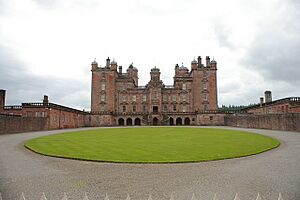Drumlanrig Castle facts for kids

Front of Drumlanrig Castle
|
|
| Lua error in Module:Location_map at line 420: attempt to index field 'wikibase' (a nil value). | |
| Established | 14th century |
|---|---|
| Location | Thornhill, Dumfries and Galloway, Scotland, United Kingdom |
| Owner | Montagu-Douglas-Scott Dukes of Buccleuch and Queensberry |
Drumlanrig Castle is a beautiful historic castle in Dumfries and Galloway, Scotland. It is located on the large Queensberry Estate. This amazing castle is the home in Dumfriesshire for the Duke of Buccleuch and Queensberry.
The castle itself is open to visitors only at certain times of the year. However, the areas around it, like the stableyard and a fun adventure playground, are open almost all year. You can also enjoy walking, hiking, and cycling paths throughout the year. Sometimes, these paths might close if there's bad weather, like when Storm Arwen caused damage in 2021.
Contents
Building the Castle
The Pink Palace
Drumlanrig Castle is often called the 'Pink Palace'. It was built between 1679 and 1689. The castle is made from a special pink sandstone. It is a great example of Renaissance architecture from the late 1600s.
The first Duke of Queensberry, William Douglas, had the castle built. It stands on the spot where an old Douglas family fort used to be. The castle overlooks the beautiful Nith Valley. It has 120 rooms, 17 small towers called turrets, and four large towers.
Roman Fort Discovery
In 1984, special aerial photos showed something amazing. They revealed the shape of a large Roman fort. This fort was about 350 yards southeast of Drumlanrig Castle. In 2004, the Time Team TV show even dug up parts of the fort to learn more about it.
Castle Gardens
Early Garden Design
A fancy garden was created at Drumlanrig between 1675 and 1697. It followed the ideas of a famous architect named Sir William Bruce. The garden looked similar to plans for other grand houses like Kinross House and Balcaskie.
The gardens had stone walls around them. They also featured six stone buildings with special lead roofs that matched the castle. There were even water features, including a "clanging clock."
Changes Over Time
In 1695, the second duke took over the estate. He hired a gardener named James Wood. James was sent to London for more training but never came back. So, the duke hired a Dutch gardener instead. In 1698, a summer house and water cascades were added to the garden.
Later, from 1714 to 1747, a gardener named David Low worked there. During his time, more landscape features were added. An early bowling green was also created. From 1728 to 1732, Sir John Clerk of Penicuik designed even more water cascades.
After David Low passed away in 1747, fewer gardeners worked at the castle. The gardens were not kept up as well. By 1810, it was decided to remove the formal gardens.
Art Collection
Drumlanrig Castle is home to a part of the amazing Buccleuch art collection. This collection includes many famous artworks.
One famous painting is Rembrandt's An Old Woman Reading. Another is Leonardo da Vinci's Madonna of the Yarnwinder. This painting was stolen in 2003 but was found in Glasgow and returned in 2007. The Madonna of the Yarnwinder is currently on display at the Scottish National Gallery. The castle also has many other paintings, tapestries, and beautiful art objects.
Fun Things to Do
The castle has many attractions for visitors and local people. These are located in the old stable yard and a part of the rear gardens. You can find the Stableyard Studios there, which have different local businesses. There's also a tearoom where you can get a snack. And don't forget the adventure playground, which is a lot of fun!
Castle Name Meaning
The name Drumlanrig was first written down in 1374 as Drumlangryg. There are a few ideas about what the name means. It might come from an old language called Cumbric. In Cumbric, drum means 'ridge' and -lanerc means 'small area of cleared woodland'.
However, the first part of the name could also come from the Gaelic word druim, which also means 'ridge'. This might have been added to a Cumbric name or to the Scots word *lang-rigg, meaning 'long ridge'.
Gallery
See also
 In Spanish: Castillo de Drumlanrig para niños
In Spanish: Castillo de Drumlanrig para niños
- Tibbers Castle – A 12th-century castle mound and fort on the Drumlanrig Castle estate.
- Treasure Houses of Britain – A 1985 TV series that showed the castle in detail.








